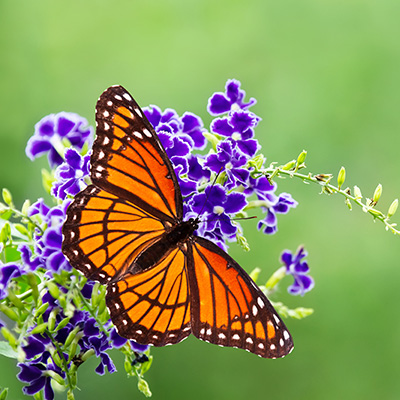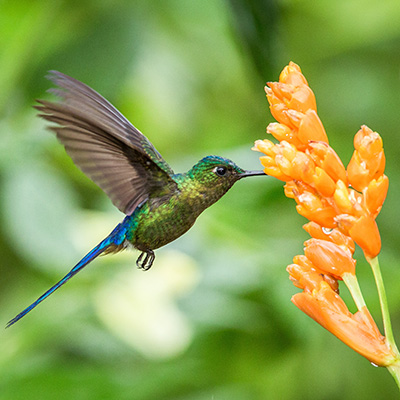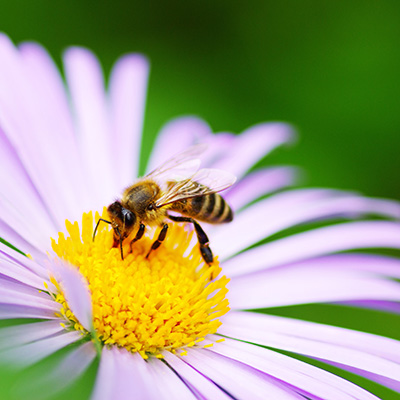There’s been a lot of buzz recently about the advantages of having pollinators in our gardens and outdoor areas. Some of the most commonly known creatures that aid in pollinating our plants and crops are bees, butterflies, and hummingbirds. Not only are they helpful, we often delight in observing them while unwinding in our yard or garden.
Pollination Definition: Pollination occurs when pollen is moved within flowers or carried from flower to flower by pollinating animals such as birds, bees, bats, butterflies, moths, beetles, or other animals, or by the wind.
When thinking about creating a pollinator-friendly habitat, is there a specific type of pollinator you would like to attract: bee, butterfly, hummingbird, or other? Here are some plants to attract each species.
Want to Attract Hummingbirds to Your Garden?
You can create a hummingbird habitat in your desert garden landscape with plants that not only grow well in Tucson but will also be enjoyed by you and your pollinating friends! Since hummingbirds are attracted to colors, not smells, they most often prefer plants with reds, oranges, and dark pinks. Many of these plants have tubular-shaped flowers designed specifically for their beaks. In addition to flowering plants, hummingbirds appreciate shade trees from which they can rest and look for insects to feed on. This combination is sure to create an environment that hummingbirds will enjoy. Consider these plants for attracting hummingbirds in Tucson:
- Baja Ruellia
- Elf Aloe
- Scarlet Bottlebrush
- Desert Willow
- Star Flower
- Emu Bushes
- Firebush
- Firecracker Plant
- Lantana
- Mexican Honeysuckle
- Red Yucca
- Summer Snapdragon
- Trumpet Vine
- Yellow Bells
How to Create a Butterfly Habitat in Tucson
You can attract butterflies to your garden regardless of its size or location. To increase your chances of success, there are four key elements to consider when designing your garden landscape:
- Water — Provide an occasional water source for puddling.
- Shade — Include a large shrub or tree to provide shade from the heat and a resting area for butterflies in the evening.
- Nectar Plants — Incorporate butterfly-friendly plants that bloom throughout the butterfly season and offer nectar to sustain adult butterflies. Different plants offer nectar at different times of the year, so aim to have a variety of plants that bloom in the spring, summer, and fall.
- Host Plants — These are plants where butterflies lay their eggs, and the hatched caterpillars feed on the leaves and flowers. Include both annual and perennial host plants to provide a continuous supply of food for the caterpillars.
By incorporating these four elements into your garden, you can create an optimum butterfly habitat and enjoy the beauty of these delicate creatures. You can attract and help butterflies thrive in your desert landscape with these gorgeous plants:
- Baja Fairy Duster
- Chaste Tree
- Fern-leaf Lavender
- Lantana
- Sunflowers
- Verbena
- Citrus Trees including Lemon, Lime, Orange, and Grapefruit
- Brittlebush
- Heartleaf Iceplant (Baby Sun Rose)
- Ornamental Grasses
- Milkweed
- Passion Vine
Create a Bee-Friendly Environment
There are many plants that can attract bees in Tucson, Arizona. Here are a few examples:
- Desert Willow — This tree produces beautiful pink and white flowers that are very attractive to bees.
- Agastache — This herbaceous perennial plant produces spikes of colorful flowers that are rich in nectar, making it a popular choice for attracting bees.
- Penstemon — This plant produces tubular flowers that are irresistible to bees. It comes in a variety of colors and can be a great addition to any garden.
- Lavender — This fragrant herb is a favorite of bees, who love to collect its nectar and pollen. It also adds a beautiful pop of color to any garden.
- Mexican Sunflower — This plant produces large, bright orange flowers that are a favorite of bees, butterflies, and other pollinators.
- Globe Mallow — This desert shrub produces beautiful orange, pink, or red flowers that are a favorite of bees.
- Desert Marigold —This perennial plant produces yellow daisy-like flowers that are a favorite of bees and other pollinators.
- Arizona Poppy — This wildflower produces bright yellow flowers that bloom in the spring and summer, attracting bees and other pollinators.
These are just a few examples of plants that can attract bees in Tucson. It’s important to note that different species of bees may be attracted to different types of flowers, so it’s a good idea to include a variety of plants in your garden to attract a diverse range of pollinators.



